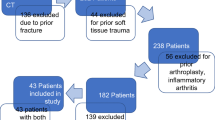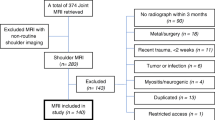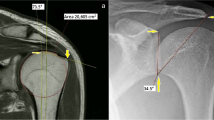Abstract
Objective
Orthopaedic surgical studies have shown that variations in the vertical distance between the tip of the coracoid process and the supra-glenoid tubercle alter the shape of the subcoracoid outlet. Our objective was to measure the vertical distance between the coracoid tip and the supra-glenoid tubercle (CTGT) on MR and to assess whether this showed better correlation with rotator cuff pathology compared with the axial coraco-humeral distance.
Materials and Methods
A retrospective review was performed of 100 consecutive shoulder MR arthrograms. Vertical distance between the coracoid tip and the supraglenoid tubercle was measured in the sagittal oblique plane. Separate assessment was then made of tendon pathology of the subscapularis, supraspinatus and long head of biceps tendons. Axial coraco-humeral distance was then measured. Correlation between tendon abnormalities and the two measurements was then made.
Results
Of the 100 cases, 42 had subscapularis tendon lesions, 21 had lesions of the long head of biceps and 53 had supraspinatus tendon lesions. Mean vertical distance from the coracoid tip to supraglenoid tubercle was greater in those with lesions of any of these tendons and was statistically significant for the supraspinatus group (P = 0.005). Reduced axial coraco-humeral distance was also seen in patients with tendinopathy, although with less statistically significant difference (p = 0.059).
Conclusion
Our results support orthopaedic studies that have shown that the vertical distance between the coracoid tip and the supraglenoid tubercle increases the incidence and risk of rotator cuff disease by altering the shape of the subcoracoid outlet.







Similar content being viewed by others
References
Okoro T, Reddy VR, Pimpelnarkar A. Coracoid impingement syndrome: a literature review. Curr Rev Musculoskelet Med. 2009;2:51–5.
Kragh JF, Doukas WC, Basamania CJ. Primary coracoid impingement syndrome. Am J Orthop. 2004;33:229–32.
Freehill MQ. Coracoid impingement: diagnosis and treatment. J Am Acad Orthop Surg. 2011;19:191–7.
Giaroli EL, Major NM, Lemley DE, Lee J. Coracohumeral interval imaging in subcoracoid impingement syndrome on MRI. Am J Roentgenol. 2006;186:242–6.
Lo IK, Burkhart SS. The etiology and assessment of subscapularis tendon tears: a case for subcoracoid impingement, the roller-wringer effect, and TUFF lesions of the subscapularis. Arthroscopy. 2003;19:1142–50.
Pfirrmann CWA, Zanetti M, Weishaupt D, Gerber C, Hodler J. Subscapularis tendon tears: detection and grading at MR arthrography. Radiology. 1999;213:709–14.
Neer 2nd CS. Impingement lesions. Clin Orthop. 1983;173:70–7.
Bigliani LU, Morrison DS, April EW. The morphology of the acromion and its relationship to rotator cuff tears. Orthop Trans. 1986;10:228.
Tuite MJ, Toivonen DA, Orwin JF, Wright DH. Acromial angle on radiographs of the shoulder: correlation with the impingement syndrome and rotator cuff tears. AJR Am J Roentgenol. 1995;165(3):609–13.
Nyffeler RW, Werner CML, Sukthankar A, Schmid MR, Gerber C. Association of a large lateral extension of the acromion with rotator cuff tears. J Bone Joint Surg (Am). 2006;88(4):800–5.
Friedman RJ, Bonutti PM, Genez B. Cine magnetic resonance imaging of the subcoracoid region. Orthopedics. 1998;21(5):545–8.
Conflict of interest
The authors declare that they have no conflict of interest.
Author information
Authors and Affiliations
Corresponding author
Rights and permissions
About this article
Cite this article
Porter, N.A., Singh, J., Tins, B.J. et al. A new method for measurement of subcoracoid outlet and its relationship to rotator cuff pathology at MR arthrography. Skeletal Radiol 44, 1309–1316 (2015). https://doi.org/10.1007/s00256-015-2166-9
Received:
Revised:
Accepted:
Published:
Issue Date:
DOI: https://doi.org/10.1007/s00256-015-2166-9




